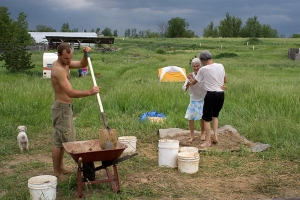 In 2006 Lin and I started camping in a field in Iowa. When our tent was flattened by a thunderstorm, we bought a 1964 Manorette on ebay for $700 and towed it from Wisconsin. This was our home in the summer of 2007 while we built our 14×18′ cob house. You can see the RV in the distance behind our son Mani who flew back from college to help us get started. That’s my mom and her dancing partner Bill mixing the cob with their feet. Cob is the way peasants in southern England used to build their little thatched roof cottages. All it takes is clay soil, sand or other aggregate and some straw to make a structural and sculptural material.
In 2006 Lin and I started camping in a field in Iowa. When our tent was flattened by a thunderstorm, we bought a 1964 Manorette on ebay for $700 and towed it from Wisconsin. This was our home in the summer of 2007 while we built our 14×18′ cob house. You can see the RV in the distance behind our son Mani who flew back from college to help us get started. That’s my mom and her dancing partner Bill mixing the cob with their feet. Cob is the way peasants in southern England used to build their little thatched roof cottages. All it takes is clay soil, sand or other aggregate and some straw to make a structural and sculptural material.
 You will note the dark clouds which were very common that summer. Keeping the rain from eroding our cob walls was our greatest stress. It took ten weeks and 500 batches of cob to create walls that were a foot and a half thick. More than 60 people helped out, giving many work days to the project and making it a community building as well as a house building experience.
You will note the dark clouds which were very common that summer. Keeping the rain from eroding our cob walls was our greatest stress. It took ten weeks and 500 batches of cob to create walls that were a foot and a half thick. More than 60 people helped out, giving many work days to the project and making it a community building as well as a house building experience.
The picture below shows the always popular cob toss. Cob gets its name from the shape of the balls that the material is formed into so that it can be passed from the mixers to the wall builders. Cob is an old English word for something roundish. Round bread could be called cob as were goblins if they appeared as a dark lump in the road at night.
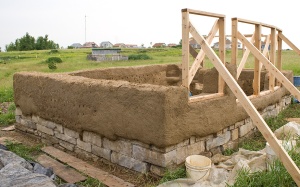 There is no frame in a traditional cob structure nor are any forms used. Wood bucks are built into the walls to receive doors and windows. Lin and I learned cob from Ianto Evans and his wife Linda Smiley at their homestead in southern Oregon. There it was common to put an old piece of glass directly into a cob wall. When we tried this in Iowa we had condensation running down the glass into the cob. Cold climates require good windows!
There is no frame in a traditional cob structure nor are any forms used. Wood bucks are built into the walls to receive doors and windows. Lin and I learned cob from Ianto Evans and his wife Linda Smiley at their homestead in southern Oregon. There it was common to put an old piece of glass directly into a cob wall. When we tried this in Iowa we had condensation running down the glass into the cob. Cold climates require good windows!
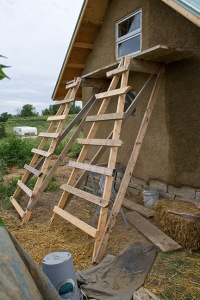 Ianto’s cool scaffold design is featured in his book, The Hand Sculpted House, which is the best book on designing and building small homes that we have found.
Ianto’s cool scaffold design is featured in his book, The Hand Sculpted House, which is the best book on designing and building small homes that we have found.
 We went with a metal roof after considering many more natural options. The metal is best for capturing rain water.
We went with a metal roof after considering many more natural options. The metal is best for capturing rain water.
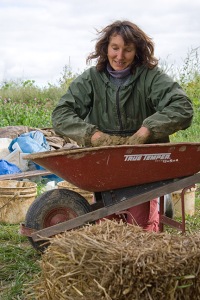
You would never know Lin was mixing fresh cow dung. In the years since this picture was taken this has become an increasingly important component in our exterior plasters.
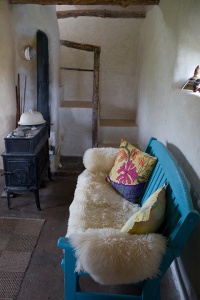 Friends gave us a retired Taiwan “Jotul” woodstove which is our version of central heating. In a cob house it is important put the stove away from the exterior walls if the outside temps stay below freezing. Otherwise heat from the stove can easily go out of the house thru the wall.
Friends gave us a retired Taiwan “Jotul” woodstove which is our version of central heating. In a cob house it is important put the stove away from the exterior walls if the outside temps stay below freezing. Otherwise heat from the stove can easily go out of the house thru the wall.
 The cozy kitchen is a little too cozy. Lin will use the summer kitchen as long as she can and is currently using the gypsy camper as her winter kitchen.
The cozy kitchen is a little too cozy. Lin will use the summer kitchen as long as she can and is currently using the gypsy camper as her winter kitchen.
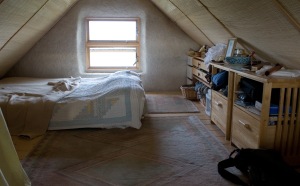 The Loft on the other hand has worked for us. There is good cross ventilation with awning windows at each end to keep it cool in the summer and heat naturally rises in the winter. The queen size bed tucks into the eave very efficiently.
The Loft on the other hand has worked for us. There is good cross ventilation with awning windows at each end to keep it cool in the summer and heat naturally rises in the winter. The queen size bed tucks into the eave very efficiently.
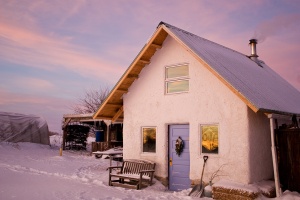 Six years have passed sin!ce the summer that produced this house. How many friendships were made mixing cob and making plaster Unfortunately, our cob house is not always as warm as those friendships. In a climate like Iowa, cob is best kept indoors in floors, inside walls and rocket stoves where it can provide positive thermal mass without losing its heat to the frigid winter. But don’t think I am second guessing our decision to build with cob. Cob bonded us to the land and to our new tribe.
Six years have passed sin!ce the summer that produced this house. How many friendships were made mixing cob and making plaster Unfortunately, our cob house is not always as warm as those friendships. In a climate like Iowa, cob is best kept indoors in floors, inside walls and rocket stoves where it can provide positive thermal mass without losing its heat to the frigid winter. But don’t think I am second guessing our decision to build with cob. Cob bonded us to the land and to our new tribe.


How cold does your home get with the rocket mass heater going in Iowa? Are you able to keep it warm enough, or would you need another heat source or different type of insulation either on outside or inside wall when constructing? Any ideas on what type of greenhouse would be best in Iowa? I was considering a lean to onto our regular home to utilize the heat from it during the daytime winter hours, or was wondering if a free standing one would be better with a rocket mass heater in it.
Two good questions. The cob house isn’t the one with the rocket mass heater, that is what I call the bale/cob experiment. The rocket stove keeps it quite toasty, but the house is small and has straw/clay insulation. In Iowa you need insulation whatever heat source you are using.
Our greenhouse is detached with an insulated north wall and roof. Winter sun warms 300 gallons of water in barrels along the north wall and they provide warmth over night. Last winter was severe and we did not have greens growing but started seeds early. The attached greenhouse can be tricky in an extreme climate like Iowa. In a winter like this last one you will be giving up heat from your living space to keep plants alive. Then in the summer you may be gaining too much heat. You might be better off with an area for plants inside the house that has roof over hang to protect from summer sun.
What a beautiful home. I am in Iowa as well and I’m researching building a cob house. I saw your comments on Iowasource.com which led me to this page. On that site, you said “A solid cob wall is not ideal for a climate like Iowa. Use cob on the inside where it can act as positive thermal mass, but build exterior walls that have more insulation.”
It seems this is something you learned since you made the house, right – so the house does not have the exterior walls with more insulation? That seems to be what I’m understanding from the images, which appear to be just cob in the walls, if I’m interpreting correctly.
How do you feel about the house now that you’ve built it? How hard of work was it? I’m on my own, so if I end up building one, it will likely be by myself most of the time. I noticed you said you had a lot of help – how long do you think it would take if you do it alone? Would you recommend a different type of natural shelter instead of cob, such as earthbag or straw bale instead of cob?
Thank you!
Yes, this article was written seven years after building our cob house so you are hearing the voice of experience. I would not do a house here with solid cob walls for several reasons. First is lack of insulation. Second is the challenge of building a slow and vulnerable wall of cob in our crazy Iowa weather. Here we need to get closed in fast. Our biggest stress building with cob was trying to protect the walls from erosion before we got the roof on. Temporary roof structures are challenging because storms can take them down and the wind driven rain goes sideways. Finally, in your situation I would not do cob because it is very labor intensive and should not be done alone. If cob isn’t a party, what’s the point? Be sure to read the article about costs which tries to dispel the idea that cob is cheap. If you can come to Fairfield we have many natural builders here using different systems. Experience is key in any system. If you don’t have it, work with someone who does at least to get closed in.
I would love to come to Fairfield and see the ecovillage. I bet it is amazing. What do you think about earthbag houses then? Do you think the same temperature issues (and moisture issues) would exist with an earthbag house? It seems they are easier and faster to build than cob. Thank you for your response.
My wife and I are curious about cob houses as well. Do you offer tours of your place?
Yes, over 1,000 visitors have toured our site. However, as of this fall, our cob house is no longer a cob house. We needed more space and also a better insulated exterior so we propped up the roof, took down the cob walls and built insulated stud walls. We actually doubled our interior space under the old roof! I will put up a new page explaining this major rebuild. We still have cob on the inside of Anna’s house and in her rocket stove, but we confirmed that it is not a good exterior wall system for a climate like Iowa.
Thanks for your honesty. Bill, http://www.eternalkeys.ca